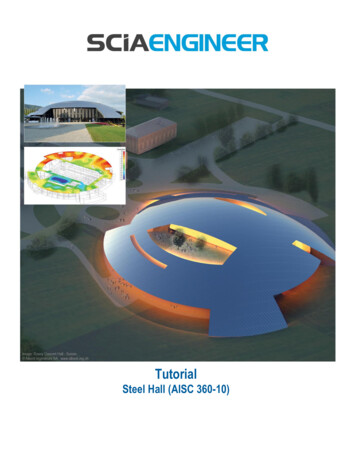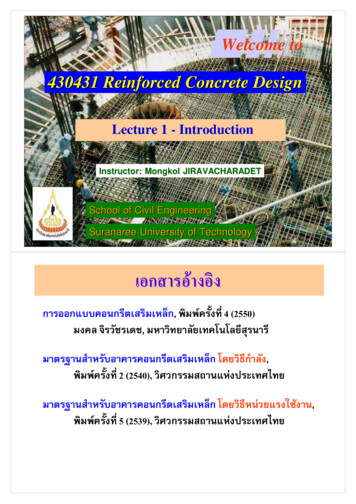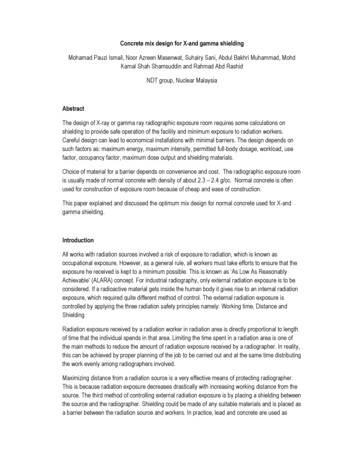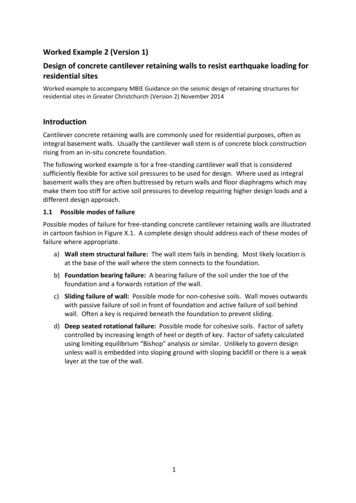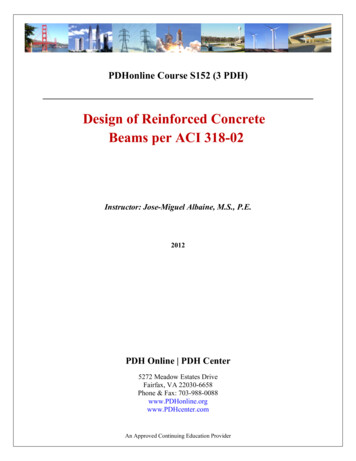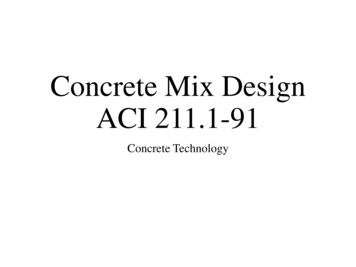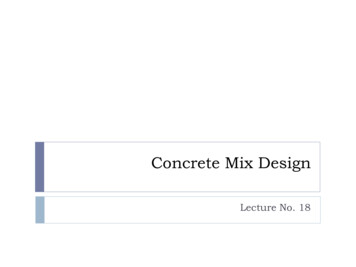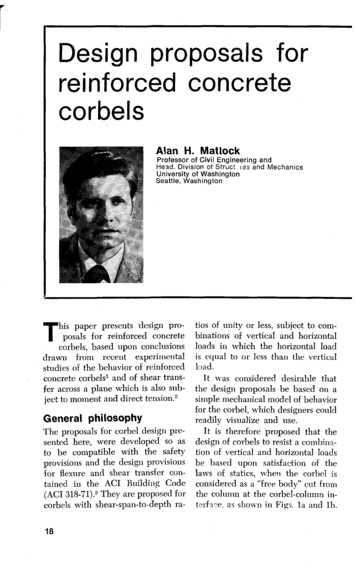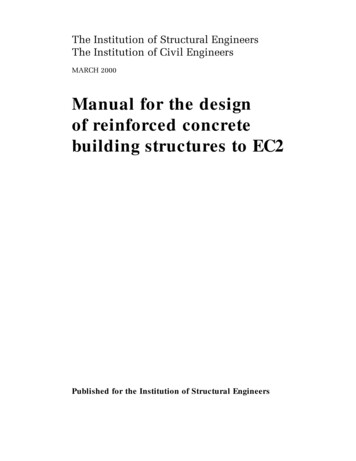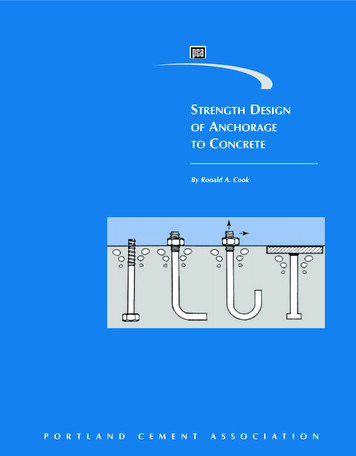
Transcription
This Design manual I summarises the reached knowledge in the RFCS Project RFSRCT-2007-00051 New Market Chances for Steel Structures by Innovative FasteningSolutions between Steel and Concrete, INFASO. The material was prepared incooperation researchers from Institute of Structural Design and Institute of ConstructionMaterials, Universität Stuttgart, Department of Steel and Timber Structures, CzechTechnical University in Prague, and practitioners from Gabinete de Informáticae Projecto Assistido Computador Lda., Coimbra, Goldbeck West GmbH, Bielefeld,stahl verbundbau GmbH, Dreieich and European Convention for ConstructionalSteelwork, Bruxelles, one targeting on fastening technique modelling and othersfocusing to steel joint design.The models in the text are based on component method and enable the design of steel toconcrete joints in vertical position, e.g. beam to column or to wall connections, andhorizontal ones, base plates. The behaviour of components in terms of resistance,stiffness, and deformation capacity is summed up for components in concrete and steelparts: header studs, stirrups, concrete in compression, concrete panel in shear, steelreinforcement, steel plate in bending, threaded studs, embedded plate in tension, beamweb and flange in compression and steel contact plate. In the Chapters 5 and 6 aredescribed the possibility of assembly of components behaviour into the whole jointbehaviour for resistance and stiffness separately. The presented assembly enables theinteraction of normal forces, bending moments and shear forces acting in the joint. Theglobal analyses in Chapter 7 is taken into account the joint behaviour. The connectiondesign is sensitive to tolerances, which are recapitulated for beam to columnconnections and base plates in Chapter 8. The worked examples in Chapter 9demonstrates the application of theory to design of pinned and moment resistant baseplates, pinned and moment resistance beam to column connections and the use ofpredicted values into the global analyses.Ulrike Kuhlmann, Jan Hofmann, František Wald,, et alISBN 978-80-01-05439-0February 2014František Wald, Jan Hofmann, Ulrike Kuhlmann et alPrinting in Publishing house of CTU in Prague - productionDesign of Steel-to-Concrete JointsDesign of Steel-to-Concrete JointsDesignof Steel-to-Concrete JointsDesign Manual IIUlrike KuhlmannFrantišek WaldJan Hofmannet alDeliverable of a project carried out with a financial grantfrom the Research Fund for Coal and Steel of the European Community
Designof Steel-to-Concrete JointsDesign Manual IPrague, Stuttgart, Coimbra, and Brussels, February 2014Deliverable of a project carried out with a financial grantfrom the Research Fund for Coal and Steel of the European Community
Design of steel-to-concrete joints, Design manual IAlthough all care has been taken to ensure the integrity and quality of this publication and the information herein, no liability isassumed by the project partners and the publisher for any damage to property or persons as a result of the use of this publicationand the information contained herein.Reproduction for non-commercial purpose is authorised provided the source is acknowledged and notice is given to the projectcoordinator. Publicly available distribution of this publication through other sources than the web sites given below requires theprior permission of the project partners. Requests should be addressed to the project coordinator: Universität Stuttgart, Institut fürKonstruktion und Entwurf / Institute for Structural Design, Pfaffenwaldring 7, 70569 Stuttgart, Germany.The present document and others related to the research project INFASO RFSR-CT-2007-00051 New Market Chances for SteelStructures by Innovative Fastening Solutions between Steel and Concrete and the successive dissemination project RFS2-CT2012-00022 Valorisation of Knowledge for Innovative Fastening Solution between Steel and Concrete, which have been co-fundedby the Research Fund for Coal and Steel (RFCS) of the European Community.ISBN 978-92-9147-119-5František Wald, Jan Hofmann, Ulrike Kuhlmann,Šárka Bečková, Filippo Gentili, Helena Gervásio, José Henriques, Markus Krimpmann, Ana Ožbolt, Jakob Ruopp,Ivo Schwarz, Akanshu Sharma, Luis Simoes da Silva, and Jörg van Kann.Printing by European Convention for Constructional SteelworkFebruary 2014178 pages, 138 figures, 32 tablesII
ContentsSYMBOLS . VI1INTRODUCTION. 102COMPONENT METHOD FOR STEEL TO CONCRETE JOINTS . 122.1Design method. 122.2Classification of joints . 132.2.1Global analyses . 132.2.2Stiffness . 152.2.3Strength . 162.2.4Deformation capacity . 172.3Steel-to-concrete joints . 182.3.1Available models. 182.3.2Steel and composite structures . 182.3.3Concrete structures . 212.3.4Components for joints with anchor plate . 213COMPONENTS IN CONCRETE. 243.1Component model for headed studs . 243.1.1Headed studs in tension, component S . 243.1.2Headed studs in tension, component CC . 253.1.3Stirrups in tension, component RS . 273.1.4Stirrups in tension - bond failure, component RB . 283.1.5Headed studs in tension, component P . 293.1.6Headed studs in shear, component V . 303.2Combination of components . 313.2.1Combination of concrete cone and stirrups, C1 CC RS/RB. 313.2.2Combination of steel and pullout, C2 S P . 323.2.3Combination of all components, C3 CC RS/RB P S . 333.2.4Design failure load . 333.2.5Combination of tension and shear components . 343.3Simplified stiffness’s based on technical specifications . 343.3.1Headed stud in tension without supplementary reinforcement . 343.3.2Headed stud in shear . 353.3.3Concrete breakout in tension. 353.3.4Pull out failure of the headed studs . 363.3.5Interaction of components for concrete and stirrups . 373.3.6Determination of the failure load. 383.3.7Friction . 38III
3.43.4.1Concrete 3D strength . 383.4.2Base plate flexibility . 403.4.3Component stiffness . 413.5Concrete panel . 433.6Longitudinal steel reinforcement in tension . 453.7Slip of the composite beam . 464STEEL COMPONENTS . 474.1T-stub in tension . 474.1.1Model . 484.1.2Resistance . 504.1.3Stiffness . 574.2Threaded stud in tension . 584.3Punching of the anchor plate . 584.4Anchor plate in bending and tension . 594.5Column/beam flange and web in compression . 634.6Steel contact plate . 644.7Anchor bolts in shear . 645ASSEMBLY FOR RESISTANCE . 665.1Column base. 665.1.1Column base with base plate . 665.1.2Column base with anchor plate . 685.2Simple steel to concrete joint . 695.3Moment resistant steel to concrete joint . 756ASSEMBLY FOR STIFFNESS . 776.1Column base. 776.1.1Column base with base plate . 776.1.2Column base with anchor plate . 796.2Simple steel-to-concrete joint . 806.3Moment resistant steel to concrete joint . 847IVBase plate in bending and concrete block in compression . 38GLOBAL ANALYSIS INCLUDING JOINT BEHAVIOUR . 847.1Structural analysis . 847.2Examples on the influence of joint behaviour . 887.2.1Reference building structures . 887.2.2Design . 907.2.3Structural model. 917.2.4Analysis and discussion for Service Limit State . 977.2.5Analysis and discussion for Ultimate Limit State . 100
8TOLERANCES . 1028.1Standardized tolerances . 1028.2Recommended tolerances.
reinforcement, steel plate in bending, threaded studs, embedded plate in tension, beam web and flange in compression and steel contact plate. In the Chapters 5 and 6 are described the possibility of assembly of components behaviour into the whole joint behaviour for resistance and stiffness separately. The presented assembly enables the

